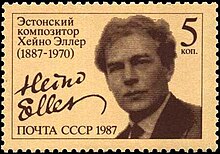Heino Eller
Heino Eller (born March 7, 1887 in Tartu , † June 16, 1970 in Tallinn ) was an Estonian composer and music teacher.
Live and act
Early years
Heino Eller graduated from school in Tartu in 1907. Since early youth he took private violin lessons and played in numerous formations and orchestras. In 1907/08 he studied violin at the Saint Petersburg Conservatory and from 1913 to 1915 and 1919/20 composition and music theory . From 1908 to 1911 he was enrolled as a law student . During the First World War he fought as a soldier in the Russian army.
Music pedagogue
From 1920 to 1940 Eller taught composition and music theory at the Higher Music School in Tartu ( Tartu Kõrgem Muusikakool ). During his time as a university lecturer in Tartu, he shaped the so-called "Tartu Composition School". She paved the way for many high-ranking Estonian composers such as Eduard Tubin . It formed the counterpart to the so-called "Tallinn School", which was significantly influenced by Artur Kapp .
From 1940 until his death in 1970, Heino Eller was a lecturer at the Tallinna Riiklik Conservatory ( Tallinna Riiklik Conservatory ), today's Estonian Academy of Music and Drama . Important pupils of Eller were Villem Kapp , Kaljo Raid , Boris Kõrver , Anatoli Garshnek , Leo Normet , Valter Ojakäär , Uno Naissoo , Arne Oit , Jaan Rääts , Heino Jürisalu , Arvo Pärt , Alo Põldmäe and Lepo Sumera .
composer
Heino Eller is described as a talented music teacher and brilliant composer. His focus was on instrumental music . He is considered a founder of the Estonian symphony and chamber music . His symphonic works in particular achieved international fame. Its sound is described as "Nordic" and "fresh".
Heino Eller was a tonal artist. In his work, he processed traditional Estonian elements and folk tunes , but was also inspired by impressionism, expressionism and other musical trends of the 20th century. He was also shaped in particular by Frédéric Chopin , Edvard Grieg and Jean Sibelius , whom he experienced himself as a young man.
The early works Videvik (1917) and Koit (1918), as well as Neenia (1928), the Elegy for Harp and Strings (1931), the Lyric Suite (1945) and the Five Pieces for String Orchestra (1953) attracted particular attention . His complete works include three symphonies , several symphonic pieces , a violin concerto , five string quartets , four piano sonatas , two violin sonatas and over 200 smaller pieces, especially for piano (the best known are "Kellad", "Liblikas" and "13 klaveripala eesti motiividel") .
Private
Heino Eller was married to the pianist Anna Kremer, who died in a National Socialist concentration camp in 1942 .
Awards
In 1948 and 1965 Heino Eller was awarded the State Prize of the Estonian Soviet Socialist Republic , in 1965 and 1970 the Order of Lenin . In 1953 Eller received the award "Honored Artist of the Estonian SSR" and in 1967 People's Artist of the USSR ( Народный артист СССР ) .
In 1971 the Tartu Higher Music School was named after Heino Eller. A memorial plaque created by the Estonian sculptor Aime Kuulbusch is in Tallinn.
Heino Eller Music Prize
In 1998 the Estonian Theater and Music Museum founded a music prize named after Heino Eller, which is awarded annually on the artist's birthday. It honors young Estonian composers or interpreters of Heino Eller's music. The prize is endowed with 15,000 Estonian crowns .
- 1998 - Heljo Sepp
- 1999 - Toomas Trass , Juha Kangas ( Finland )
- 2000 - Helena Tulve , Mart Humal
- 2001 - Tõnu Kõrvits , Sunho Kim ( South Korea )
- 2002 - Timo Steiner , Tõnu Kaljuste , Aleksandra Juozapenaite-Eesmaa
- 2003 - Galina Grigorjeva , Urmas Vulp , Olga Voronova , Henry-David Varema , Toomas Nestor
- 2004 - Mirjam Tally , Märt-Matis Lill
- 2005 - Tõnis Kaumann
- 2006 - Ülo Krigul , Vivian Tordik
- 2007 - Mart Siimer , Alo Põldmäe
- 2008 - Tatjana Kozlova
- 2009 - Tauno Aints , Reet Remmel , Mart Humal , Rein Seppius
- 2010 - Tiia Järg
- 2011 - Sten Lassmann
- 2017 - Liisa Hirsch
Web links
- Works by and about Heino Eller in the catalog of the German National Library
- Biography, list of works, discography and literature in the Estonian Music Information Center
- Heino Eller at Allmusic (English)
- Heino Eller at Estonian Record Productions ( Memento from April 4, 2016 in the Internet Archive )
- Heino Eller Music Prize (Estonian)
Remarks
| personal data | |
|---|---|
| SURNAME | Eller, Heino |
| BRIEF DESCRIPTION | Estonian composer |
| DATE OF BIRTH | March 7, 1887 |
| PLACE OF BIRTH | at Tartu |
| DATE OF DEATH | June 16, 1970 |
| Place of death | Tallinn |

